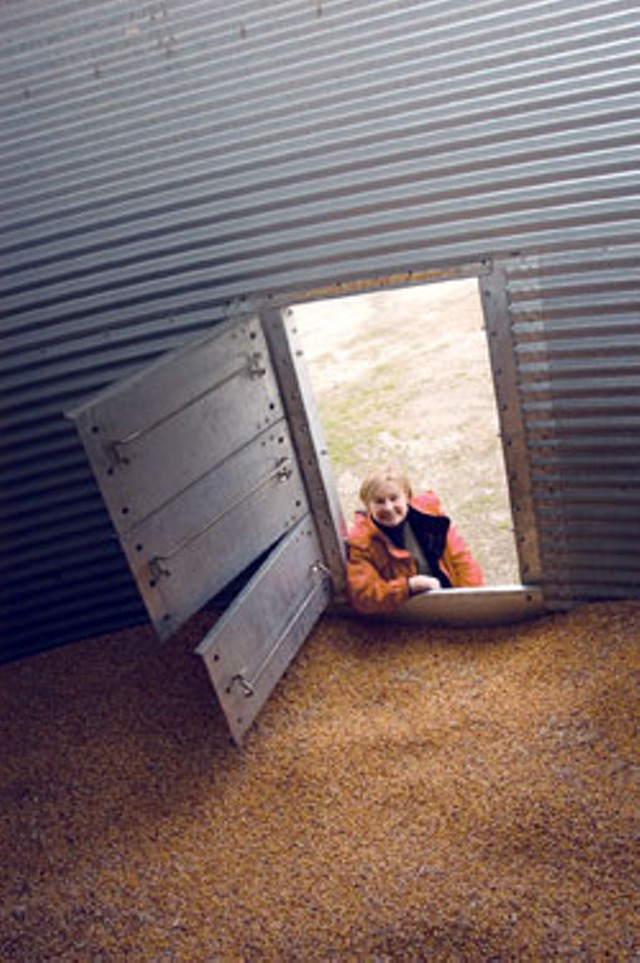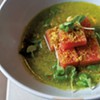Published April 14, 2009 at 5:09 p.m.
Good fences may not always make good neighbors, as Robert Frost’s old-school Vermonter in “Mending Wall” claims. But in Charlotte, a genial conversation across a fence made good business partners.
The result was the Nitty Gritty Grain Co. of Vermont, a growing artisan food business that earned a mention in Gourmet’s food newsletter on March 5. It’s a collaboration between neighbors Jane Kirby — a nutritionist and cooking teacher who spent many years in the publishing industry — and organic farmer Tom Kenyon. The pair sells cellophane bags of organic cornmeal in two varieties, plus a blend, as well as a cornmeal mix intended for whipping up quick muffins, pancakes and cornbread.
Recalling the chat that started it all, Kirby says, “I’m watching Tom Kenyon work the fields out there. One day I asked, ‘Where does that stuff go?’” Fact was, Kenyon didn’t really know. He sold his grains to an organic miller who managed the distribution.
Then Kirby had a brainstorm. “What if we added value to it right here, branded it and made it available for people in Vermont?” she proposed. The farmer — whom Kirby describes as “shy” — agreed, provided Kirby take responsibility for the business end.
Of the three crops Kenyon grows — wheat, corn and soy — Kirby, 55, thought corn might be the easiest sell. Over boiled eggs from her own hens and a sticky piece of rosemary-scented cornmeal cake, she reminisces, “I grew up with Jiffy mix. You add a little of this, turn it into that and you have dinner.”
So corn it was. Kirby and Kenyon scored a planning grant, which allowed them to do a feasibility study through 2006 and 2007. The day after the grant period ended, on July 1, 2008, Nitty Gritty was born.
Visitors approach the farm from a dusty dirt road near Lake Champlain. In early spring, the tops of winter wheat stalks are just greening up, and the year’s corn hasn’t yet been planted. Behind a bright red barn, which once housed sheep but now holds the Nitty Gritty processing room and all Kenyon’s heavy farmyard equipment, stand two medium-sized silos filled with kernels from last year’s crop.
Before Nitty Gritty, Kenyon grew only yellow corn, which is hybridized to resist disease and form neat, predictable stalks and kernels. The ease of growing and harvesting it, however, comes at the expense of texture and flavor.
The grant gave Kenyon and Kirby a chance to explore other kinds of corn. “I said, ‘If we’re going to do this, it’s gotta be so much better than everything else that’s out there or it’s not worth doing. It’s gotta be about flavor,’” says Kirby. With the help of a few experts, the pair began experimenting with so-called “open-pollinated varieties.” Although the resulting cornfields “look like a mess,” Kirby says with a smile, the flavor of the meal turned out to be worth it.
Today, to please consumers’ palates, Kenyon grows an heirloom strain called Wapsie Valley, which is stored separately from the yellow corn. To demonstrate the difference, Kirby, clad comfortably in jeans and black fleece, clambers up a step to open the silo door. Inside sit thousands of pounds of kernels in a range of autumnal colors. But, unlike the “Indian corn” used to decorate at Thanksgiving, each Wapsie Valley ear is a single color. Stalks grown from orange seeds bear orange kernels; stalks from red seeds bear red ones. When they’re all mixed together, the beauty of the corn is striking, and the nutty aroma is enchanting.
Kirby compares the gap in flavor between yellow corn and the colorful Wapsie Valley to that between hybridized tomatoes — bred to be perfectly round and red — and oddly shaped heirlooms. “Big Boy tomatoes are always the same size and shape; they always grow; you don’t have to worry about bugs. They’re fine until you taste a Brandywine.”
When she discovered Wapsie Valley, she recalls, “I thought the flavor was so spectacular that it was the corn we needed to grow to have a great product. It’s a little crunchier. The problem is that it’s more expensive.” To make the price easier for consumers to swallow, Nitty Gritty offers yellow and Wapsie Valley cornmeals separately as well as blended. On the company’s website, 3 pounds of plain yellow lists at $7.95, while the same weight of Wapsie is $12.30. A blend sells for $10.20 and goes into the baking mix, at $4.65 a pound.
Why is it such a big deal to get the right meal — something most Americans see as a featureless staple? “‘Who cares about cornmeal? Why do you want three kinds?’” demands Kirby, imitating her dad. “He grew up in a generation where it’s about how much you can get for how little.”
Kirby’s dad worked in the food field, sort of — he made Marshmallow Fluff in Lynn, Massachusetts. “I’m the daughter of a food manufacturer,” says Kirby, who keeps the Fluff-related job from her youth on her résumé. “‘Food’ in quotation marks, I guess.”
Back in the ’70s, when Kirby was finishing high school, she says, “My father kind of pushed me toward home economics. I’d always had a passion for food, and all the [women] he knew in the business had gone through this route.”
In college, though, Kirby discovered an interest in nutrition and dietetics. While doing a graduate internship at Massachusetts General Hospital, she met a surgical intern from Harvard Medical named Dean Ornish. “He used to ask nutrition questions all the time,” she recalls of the man who would become a low-fat-diet guru.
Meanwhile, Kirby was tasked with explaining to heart-attack patients which foods they would need to cut from their diets. “Many of them were Italian, from the North End, and I’d sit there and say, ‘These are all the foods you can’t eat: salami, cheese, etc.’” Kirby could see the painful effect of her pronouncements: Being denied these foods “was killing them,” she says.
Worn out from dispensing dour nutritional advice, Kirby switched career gears. An “absolute magazine addict from a young age,” she got a job at Glamour —then known as a feminist publication that dealt thoughtfully with “women’s issues” — and spent 15 busy years living it up in the Big Apple. “New York in the ’80s was a blast,” she says. “Everything was exploding; people were interested in good food and they were interested in health.”
In 1995, Kirby moved to Vermont to become the editor of EatingWell. After a difficult divorce and custody battle, she left to become a freelancer and stay-at-home mom, but her entrepreneurial streak was starting to emerge. It wasn’t long before she turned her home into a cooking school, “because people kept asking me for recipes,” she explains.
Around that time, Kirby, who had begun raising chickens and was startled by the great taste of fresh eggs, underwent a radical shift in philosophy. “I got a chance to start looking at my whole belief system about food and nutrition,” she reflects. “I slowly began to realize that it’s not what you do to the food, it’s where it comes from that’s important.”
When she began consulting for the not-yet-launched Real Simple magazine, Kirby found herself advocating some radical approaches, such as eliminating nutrition information from recipes. “I’m sick of people eating by the numbers,” she says fervently. “They’re ruled by [calorie content and fat grams] and aren’t tasting the food.”
It’s not an opinion you’d expect from the woman who wrote 1999’s Dieting for Dummies. But Kirby has become a convert to the French view of food, which, she says, is “all about flavor. If we put that kind of value on flavor, SnackWells would never have gotten off the ground.”
By the same token, she feels, American consumers have eaten up pallid hybrid tomatoes, corn and apples that may look pretty and ship well, but lack the complex flavors of their finicky brethren. If Nitty Gritty and companies like it are to succeed, consumers must relearn how to think with their taste buds rather than with calorie calculators, and to value high-quality products enough to spend more on them.
Take Wapsie Valley cornmeal, which Kirby describes as “one of those products that we need to get into people’s mouths for them to know there’s even a difference.” To that end, she’s been doing “taste test” demos at area markets with corn muffins made from Nitty Gritty’s trio of meals. “At first, I wondered if people would be sensitive enough to taste [the difference], but everyone did,” she says. “People got a kick out of it.”
With interested consumers on board, Kirby says business is going well: “We’re in most of the stores we need to be in.” The demand for Nitty Gritty grains is growing at area markets and co-ops — the Gourmet nod didn’t hurt — and Kirby is working on increasing the number of restaurant accounts.
Another part of the former glossy-mag writer’s job is mixing and bagging the cornmeal — a completely manual process that places limits on production. “At this point,” she says, “it feels like we’re only limited by my energy level.
Once she finds a way to automate some of the work, Kirby will focus on creating new product lines. “We want to look into spelt and oats,” she says. But she doesn’t want the company to get too big, nor does she intend to compete with her childhood favorite. “I want this to be a viable business; I don’t want to go up against Jiffy,” Kirby declares. “I’d be happy if this could be a well-established, regional brand.”
Want to get in touch?
Nitty Gritty Grain Co. of Vermont, PO Box 235, Charlotte, VT 05445. Info, 425-4544 or click here.
More By This Author
About the Artist

Matthew Thorsen
Bio:
Matthew Thorsen was a photographer for Seven Days 1995-2018. Read all about his life and work here.
Matthew Thorsen was a photographer for Seven Days 1995-2018. Read all about his life and work here.
Speaking of...
-

Original Glory: A Five-Year Renovation Turns Charlotte's '1812 Tavern' Into a Stunning Family Home Steeped in History
Apr 16, 2024 -

Totally Transfixed: A Rare Eclipse on a Bluebird Day Dazzled Crowds in Northern Vermont
Apr 10, 2024 -

Michael Krasnow Has Spent Decades Giving Kids Skis, Snowboards and a Taste of Independence
Jan 31, 2024 -

Stone's Throw Pizzeria to Reopen in Charlotte
Jan 16, 2024 -

Q&A: Howard Fisher Delivers Meals on Wheels With a Side of Good Cheer
Dec 20, 2023 - More »
Comments
Comments are closed.
From 2014-2020, Seven Days allowed readers to comment on all stories posted on our website. While we've appreciated the suggestions and insights, right now Seven Days is prioritizing our core mission — producing high-quality, responsible local journalism — over moderating online debates between readers.
To criticize, correct or praise our reporting, please send us a letter to the editor or send us a tip. We’ll check it out and report the results.
Online comments may return when we have better tech tools for managing them. Thanks for reading.














































